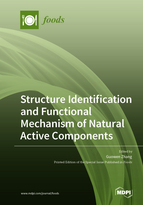Structure Identification and Functional Mechanism of Natural Active Components
A special issue of Foods (ISSN 2304-8158). This special issue belongs to the section "Plant Foods".
Deadline for manuscript submissions: closed (30 January 2022) | Viewed by 23942
Special Issue Editor
Interests: food chemistry; food analysis; interaction; mechanism of action of small compounds and biomolecules; inhibitory effect of enzymatic activity; food contaminants; bioactive compounds
Special Issues, Collections and Topics in MDPI journals
Special Issue Information
Dear Colleagues,
In recent years, the natural active components derived from plants have attracted widespread attention because of their abundant species and source advantages. With the continuous deepening of research, flavonoids, alkaloids, phenolic acids, polysaccharides, volatile oils, and other natural substances have gradually been recognized due to their extensive functional characteristics. Studies have shown that many natural active components have broad-spectrum biological activities, such as antioxidant, antihypertensive, hypoglycemic, anti-inflammatory, antibacterial, anticancer, enzyme-inhibiting activity, etc., which are valuable sources of research and development in food functional factors and novel drugs. Therefore, the development of natural functional food materials and the identification of active substances have broad research prospects. Systematical studies on the structure of components, physiological activities, structure–activity relationship, and mechanisms of action for active components using modern scientific methods and experimental means are hot research topics. In addition, the explorations of the combined effect and mechanism of various natural bioactive substances will provide a theoretical basis for the further processing and comprehensive development of resources from multiple levels and aspects. Recent advances also focus on discussions of their biological activities and stability in the food system and in vivo, which have important practical significance.
Prof. Dr. Guowen Zhang
Guest Editor
Manuscript Submission Information
Manuscripts should be submitted online at www.mdpi.com by registering and logging in to this website. Once you are registered, click here to go to the submission form. Manuscripts can be submitted until the deadline. All submissions that pass pre-check are peer-reviewed. Accepted papers will be published continuously in the journal (as soon as accepted) and will be listed together on the special issue website. Research articles, review articles as well as short communications are invited. For planned papers, a title and short abstract (about 100 words) can be sent to the Editorial Office for announcement on this website.
Submitted manuscripts should not have been published previously, nor be under consideration for publication elsewhere (except conference proceedings papers). All manuscripts are thoroughly refereed through a single-blind peer-review process. A guide for authors and other relevant information for submission of manuscripts is available on the Instructions for Authors page. Foods is an international peer-reviewed open access semimonthly journal published by MDPI.
Please visit the Instructions for Authors page before submitting a manuscript. The Article Processing Charge (APC) for publication in this open access journal is 2900 CHF (Swiss Francs). Submitted papers should be well formatted and use good English. Authors may use MDPI's English editing service prior to publication or during author revisions.
Keywords
- natural active components
- antioxidant
- structure identification
- immunoregulation
- functional mechanism
- interaction
- anti-inflammatory







